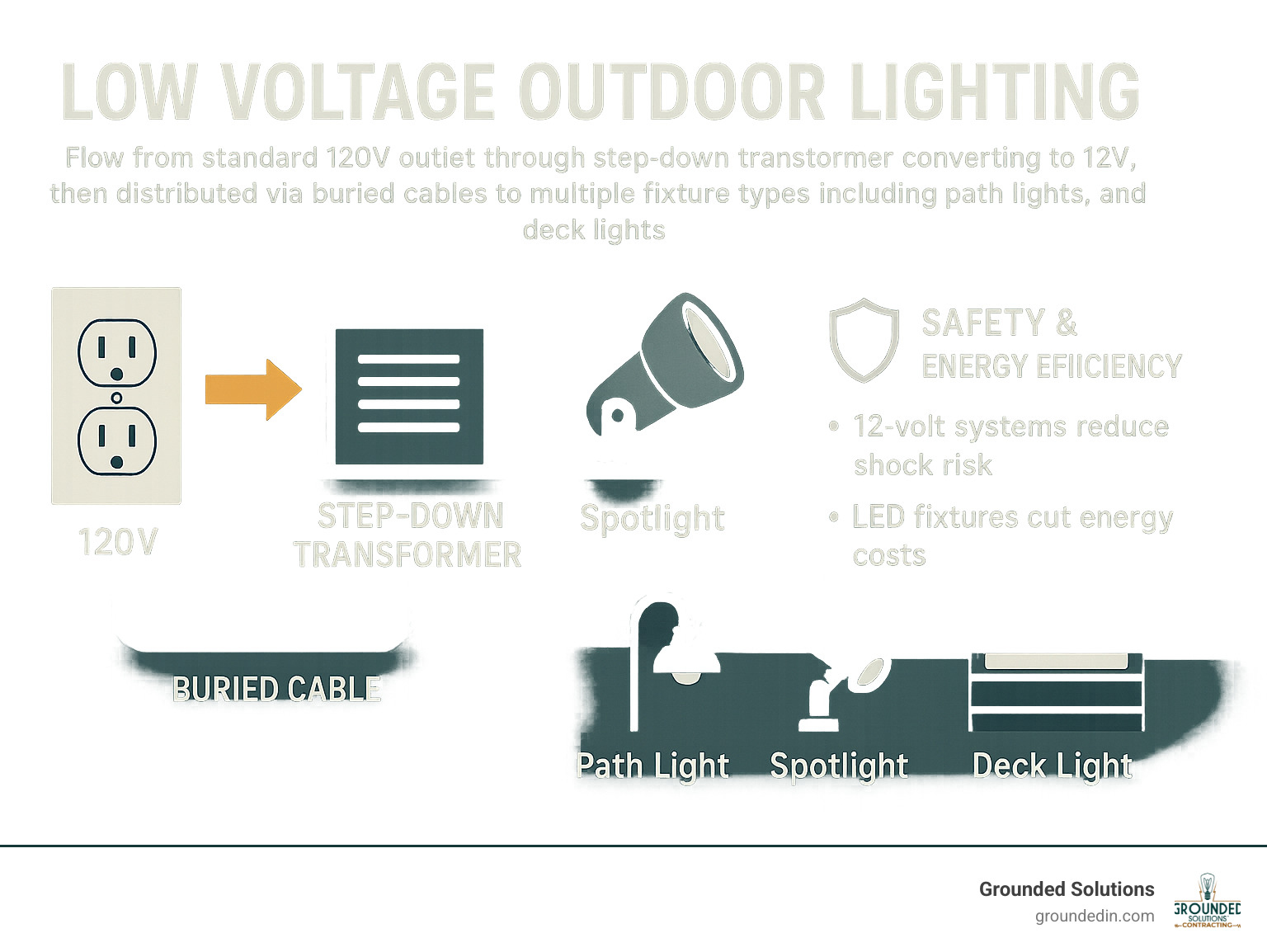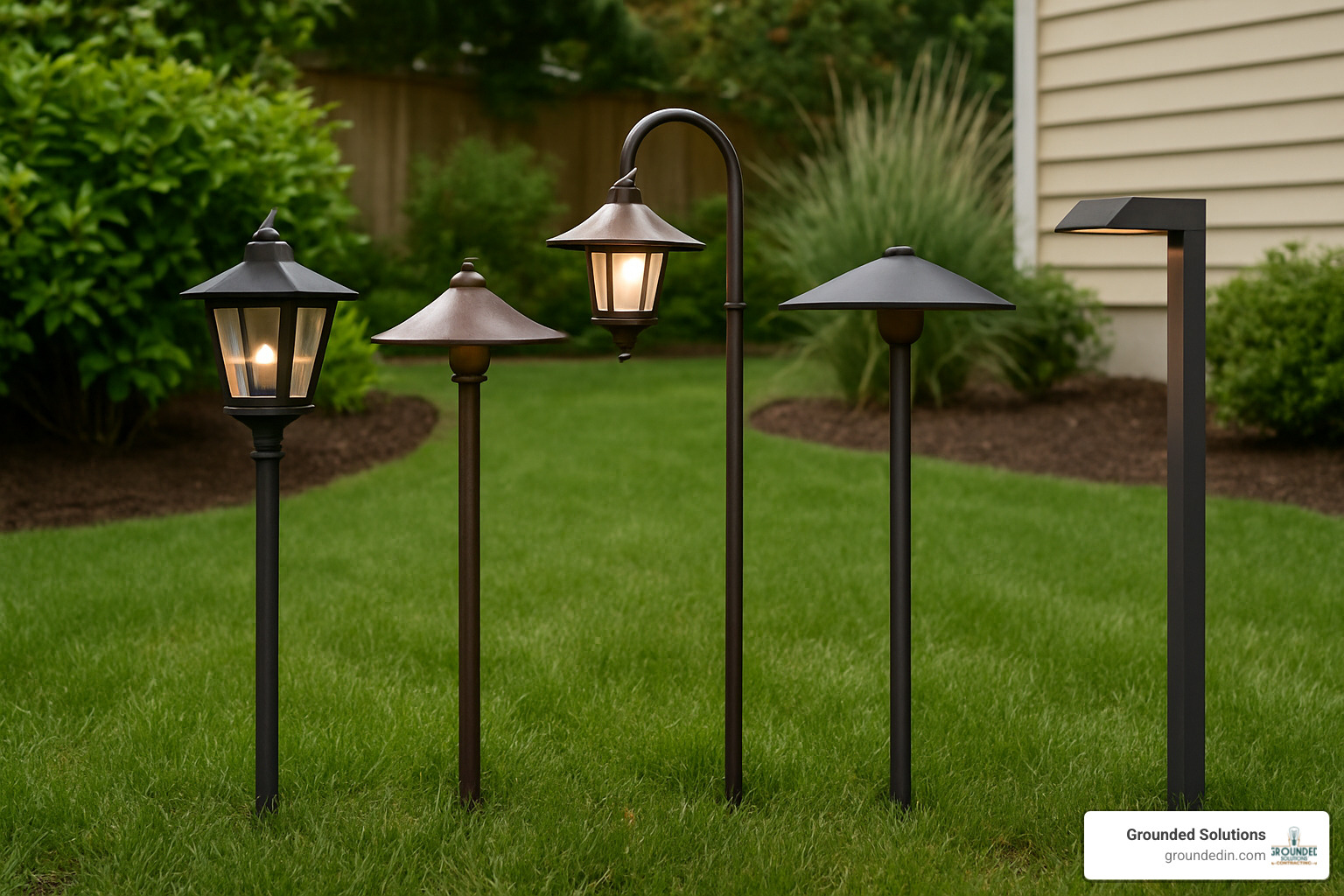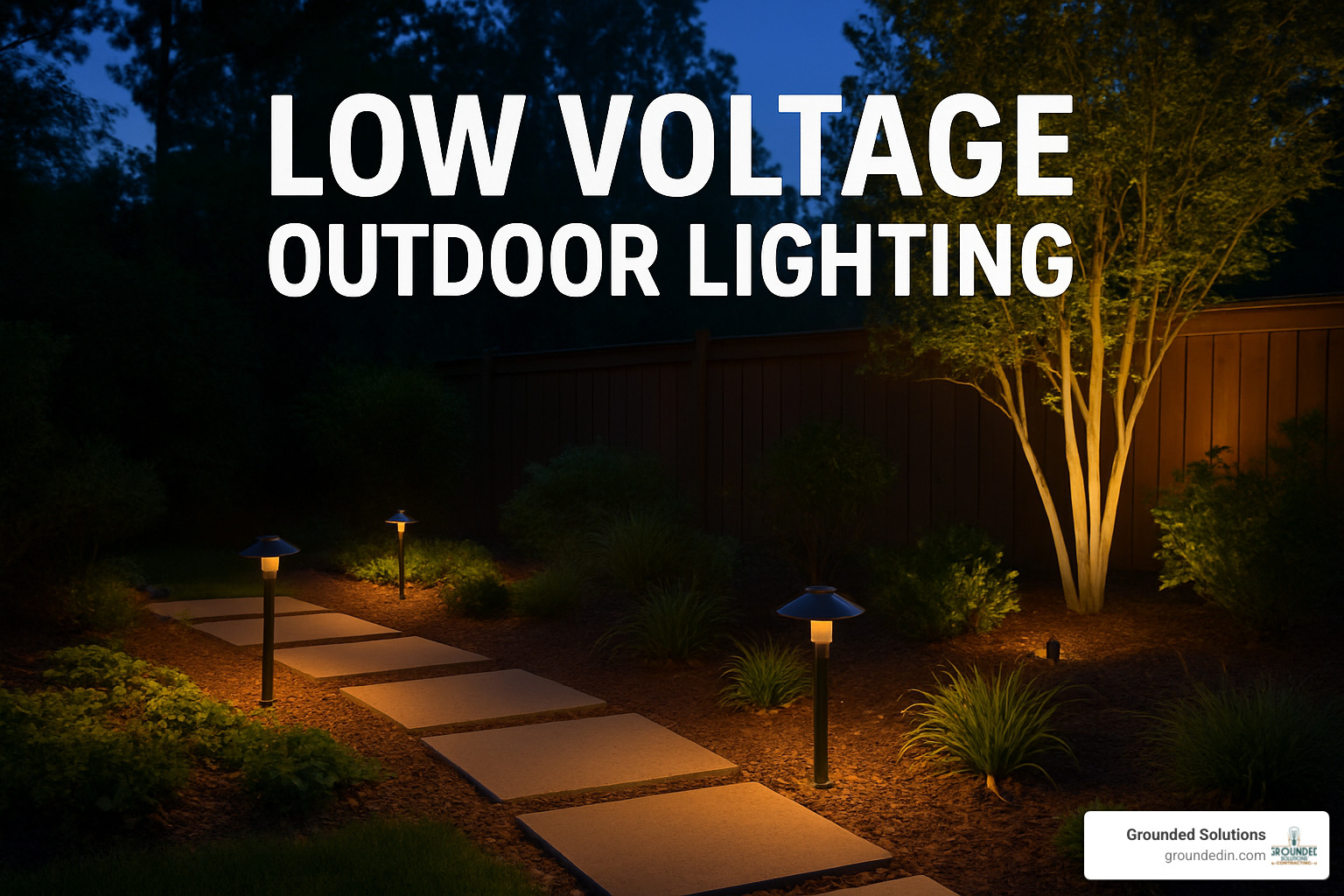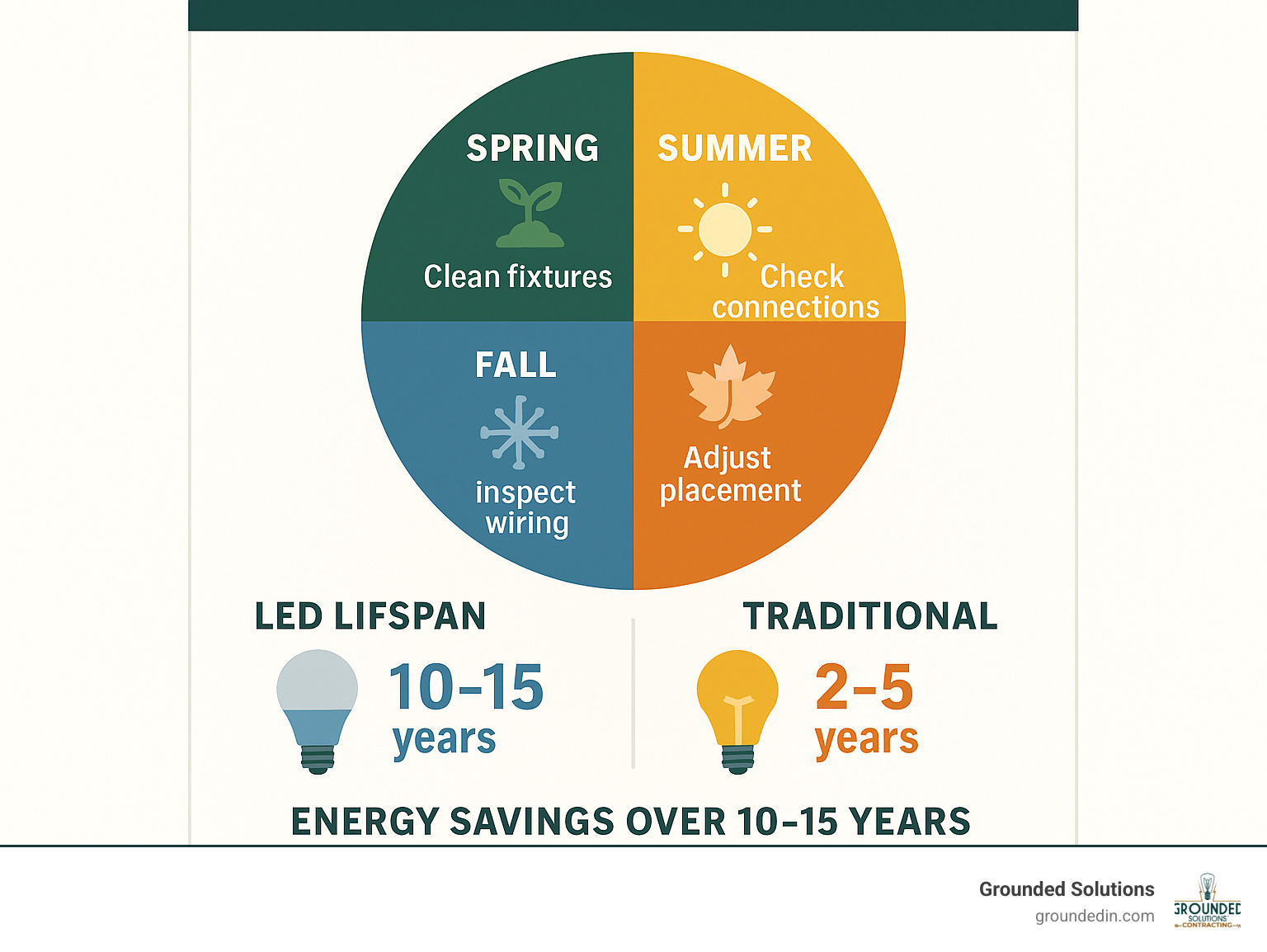Transform Your Indianapolis Property with Safe, Energy-Efficient Lighting
Low voltage outdoor lighting operates at just 12 volts instead of your home’s standard 120 volts, making it safer to install and maintain while delivering stunning results for your outdoor spaces. Here’s what makes low voltage lighting the smart choice for Indianapolis homeowners:
Key Benefits:
- Safety First – 12-volt systems reduce shock risk by 90%
- Energy Efficient – LED fixtures cut energy costs by up to 85%
- Professional Installation – Proper setup ensures optimal performance and safety
- Long-Lasting – Quality LED lights last 10-15 years
- Expandable – Easy to add more fixtures as your landscape grows
Popular Fixture Types:
- Path lights for walkways and driveways
- Spotlights for accent lighting trees and architecture
- Deck lights for entertaining areas
- Well lights for uplighting and ground effects
Low voltage systems work by using a transformer to step down your home’s 120-volt power to safe 12-volt current. This reduced voltage travels through buried cables to illuminate your fixtures with the reliability and safety that comes from professional installation.
Whether you’re highlighting your home’s architecture, improving safety along walkways, or creating ambiance for outdoor entertaining, low voltage lighting delivers professional results that withstand Indiana’s changing seasons.
As Clay Hamilton, President of Grounded Solutions with over two decades of electrical expertise, I’ve helped countless Indianapolis homeowners transform their properties with low voltage outdoor lighting systems that combine safety, efficiency, and stunning visual impact.

Quick look at low voltage outdoor lighting:
- energy efficient outdoor lighting
- exterior lighting installation services
- motion sensor lighting installation
Why Choose Low Voltage Outdoor Lighting?
When it comes to illuminating your Indianapolis outdoor spaces, low voltage outdoor lighting offers a winning combination of safety, efficiency, and flexibility that delivers exceptional results.
Safety takes center stage with 12-volt systems. While your home’s standard electrical system operates at 120 volts, low voltage lighting steps that down to just 12 volts – reducing electrical shock risk by roughly 90%. This inherent safety advantage makes low voltage systems the preferred choice for outdoor applications.
The energy savings speak for themselves. LED fixtures in low voltage systems can slash your outdoor lighting energy costs by up to 85% compared to traditional incandescent options. When you factor in the impressive LED longevity – typically 10 to 15 years of reliable operation – the long-term value becomes compelling for Indianapolis homeowners.
Low voltage outdoor lighting offers remarkable flexibility in design and installation. The reduced complexity means systems can be expanded as your landscape grows or adjusted to accommodate changes in your outdoor living spaces.
From a code-compliant perspective, low voltage systems offer advantages in terms of installation requirements, though professional installation ensures optimal performance and adherence to all local electrical codes.
| Feature | Low Voltage (12V) | Line Voltage (120V) |
|---|---|---|
| Safety Risk | Minimal shock hazard | High shock risk |
| Energy Efficiency | Up to 85% savings with LED | Higher operating costs |
| Installation Complexity | Streamlined process | Complex requirements |
| Permit Requirements | Simplified permitting | Often requires extensive permits |
| Expandability | Easy to add fixtures | Complex modifications |
| Flexibility | Fixtures easily relocated | Fixed installations |
How It Works: Transformer → Cable → Fixture
Understanding how low voltage outdoor lighting works helps you appreciate the engineering behind these sophisticated systems. The process starts with a step-down transformer – a precision device that takes your home’s 120-volt power and converts it to safe 12-volt current for your landscape fixtures.
Quality transformers do more than just convert voltage. Most come equipped with built-in timers, photocells, or both, giving you automatic dusk-to-dawn operation without any daily management.
From the transformer, power travels through specially designed outdoor cable to each fixture. 12-gauge cable works well for most residential installations, though larger systems or longer runs require careful wire sizing calculations. The key is matching your cable specifications to your total wattage and the distance power needs to travel.
Voltage drop management requires expertise in low voltage systems. As electrical current travels through wire, some voltage naturally gets lost due to resistance. Since you’re starting with just 12 volts instead of 120, this voltage drop becomes critical to system performance. Professional planning prevents fixtures from dimming or operating inconsistently.
Strategic transformer placement and proper wire sizing minimize these issues, ensuring consistent performance across your entire lighting system.
Product Roundup: Must-Have Low Voltage Fixtures for Indiana Yards

Choosing the right fixtures for your Indianapolis yard means thinking about what you want to accomplish. Are you focused on safety for nighttime walks, showcasing your beautiful landscaping, or creating the perfect atmosphere for outdoor entertaining? Most homeowners want all three, and that’s where smart fixture selection makes all the difference.
Indiana’s weather throws everything at your outdoor lighting – from steamy July nights to brutal January ice storms. Brass fixtures develop that gorgeous patina over time while laughing off our unpredictable weather. Aluminum fixtures give you excellent durability without the higher price tag, especially when they feature quality powder-coated finishes.
Beam spread completely changes how your lighting looks and works. Narrow beams (15-25 degrees) create dramatic spotlighting effects perfect for highlighting your prize oak tree. Wider beams (40-60 degrees) spread light evenly across walkways and entertaining areas where you need good visibility.
Path & Walkway Lights for Safe Strolls
Path lights are the workhorses of most low voltage outdoor lighting systems. They keep your family and guests safe while adding that welcoming glow that makes your home feel inviting after dark.
Stake-mounted designs give you incredible flexibility – something every Indianapolis homeowner appreciates. Want to adjust the lighting along your curved driveway? Easy. Need to move a fixture because you planted new shrubs? No problem.
The magic happens with warm 2700K color temperature lighting. This creates that cozy, welcoming atmosphere that makes people want to linger on your front porch or stroll through your garden. It’s bright enough for safety but soft enough to feel comfortable.
Glare-shield domes prevent harsh glare that can actually make walking more dangerous. Most walkways look best with fixtures spaced every 10-15 feet.
Accent Spotlights to Showcase Focal Points
Accent spotlights turn your ordinary yard into something magazine-worthy after sunset, highlighting the features that make your property special.
Adjustable knuckle joints are absolutely essential for accent lighting. Your trees grow, seasons change, and you might decide that fountain looks better lit from a different angle. Quality fixtures let you make these adjustments without calling an electrician.
A 40-degree beam spread hits the sweet spot for most accent applications. It’s wide enough to illuminate a good portion of your tree canopy or architectural feature, but focused enough to create real drama.
Tree uplighting deserves special attention here in Indianapolis, where mature trees add thousands to property values. Those beautiful maples and oaks that define our neighborhoods look absolutely stunning when properly lit from below.
Deck & Step Lights for Evening Entertaining
Nothing ruins a backyard gathering like someone taking a tumble down poorly lit steps. Deck and step lights solve this safety issue while creating the perfect ambiance for entertaining.
Recessed LED fixtures install flush with your decking, so they provide excellent step definition without creating tripping hazards themselves. They’re tough enough to handle foot traffic while delivering consistent light exactly where you need it.
Stair-edge lighting requires some thought to get right. You want clear illumination of each step edge without creating glare. Often, side-mounted fixtures work better than overhead lighting for this specific application.
Don’t skimp on corrosion-resistant housings for deck installations. Stainless steel or marine-grade aluminum housings provide the durability needed to look great year after year.
Specialty Fixtures: Hardscape, Underwater & Bollards
Once you’ve covered the basics, specialty fixtures let you add those sophisticated touches that really set your property apart.
Paver lights create magic by seeming to make light emerge directly from your hardscape. They integrate seamlessly into patios, walkways, and pool decks while providing subtle illumination.
Underwater lights and pond fixtures transform water features into nighttime focal points. These require proper sealing and often include color-changing capabilities for seasonal variety.
Architectural bollards serve double duty as both lighting and landscape elements. They’re perfect for defining driveways, creating visual boundaries, or adding structure to garden beds while providing functional illumination.
Planning & Installing Your Low Voltage Outdoor Lighting Layout

The magic of low voltage outdoor lighting happens long before you dig your first trench. Smart planning makes the difference between a lighting system that transforms your Indianapolis property and one that leaves you wishing you’d done things differently.
Start with a simple site sketch that maps out your property’s key features. Walk around your yard at dusk with a notepad, identifying which trees deserve uplighting, where path lights would improve safety, and which architectural features could use accent lighting.
Lumen layering creates the visual depth that separates amateur installations from professional-looking results. Mix soft pathway illumination at 50-100 lumens with dramatic accent spots delivering 200-400 lumens to create layers of light that guide the eye and highlight your property’s best features.
Transformer sizing requires some math, but it’s simpler than you might think. Add up the wattage of all your planned fixtures, then choose a transformer with 20-30% more capacity than your total. This buffer prevents overloading and gives you room to expand your system later.
Before you touch a shovel, call 811 to have underground utilities marked. This free service prevents dangerous encounters with gas lines, electrical cables, or communication wires buried in your yard.
Your transformer needs a GFCI-protected outlet to operate safely. Many older homes lack GFCI protection on outdoor outlets, which means you might need electrical work before installing your lighting system.
For comprehensive guidance custom to our region’s specific challenges, check out our detailed guide on Installing Outdoor Lighting in Your Central Indiana Home. The Electrical Safety Foundation also provides excellent resources on transformer sizing and safety considerations.
Step-By-Step Installation Overview
The best low voltage outdoor lighting installations follow a logical sequence that prevents costly mistakes and reduces frustration.
Layout planning comes first, and it’s worth taking your time here. Position your fixtures temporarily and run cable along your planned routes. Walk through your property after dark with a flashlight to simulate how the lighting will look.
Mount your transformer in a protected location at least one foot above ground level. Look for spots under eaves, in covered porches, or near other structures that shield the unit from direct rain and snow.
Trenching depth of 2-3 inches provides adequate protection for your low voltage cable without requiring deep excavation. This shallow burial protects the cable from foot traffic and lawn equipment while keeping the installation simple.
Snap-connect fixtures eliminate the wire-stripping and splicing that intimidate many DIY installers. These weatherproof connectors pierce the cable insulation to make solid contact with the conductors inside.
Testing and fine-tuning should happen before you bury anything permanently. Connect all your fixtures, turn on the system, and evaluate the results after dark. This testing phase prevents the frustration of digging up cables to fix problems later.
Smart Controls, Timers & Sensors for Effortless Operation
Modern low voltage outdoor lighting systems practically run themselves once you set them up properly. Photocells built into quality transformers automatically turn your lights on at dusk and off at dawn, adjusting to seasonal changes without any input from you.
Motion sensors add both security and energy efficiency to your lighting system. These sensors can activate accent lighting when someone approaches your property and automatically turn off lights when areas are unoccupied.
App-based control hubs bring your outdoor lighting into the smart home era. Control your lights remotely, create custom schedules that match your lifestyle, and even dim fixtures for different occasions.
Timer programming allows sophisticated control that adapts to your family’s routines and seasonal preferences. Many Indianapolis homeowners appreciate systems that automatically adjust for daylight saving time changes.
For detailed information about incorporating motion sensors into your lighting design, our comprehensive guide on Motion Sensor Lighting Installation covers the latest technology and installation best practices for central Indiana properties.
Maintaining & Expanding Your System

One of the biggest advantages of low voltage outdoor lighting is how little maintenance these systems actually need. When you invest in quality LED fixtures, you’re looking at a 10-15 year lifespan with minimal upkeep—that’s over a decade of beautiful evenings in your Indianapolis backyard without worrying about constant bulb changes or repairs.
The most important maintenance task is surprisingly simple: cleaning fixture lenses regularly. Indianapolis weather can be tough on outdoor fixtures, with everything from spring pollen to winter road salt finding its way onto your lights. When dirt and grime build up on the lenses, you can lose 20-30% of your light output without even realizing it.
For stubborn buildup—especially after those messy Indiana winters—a little mild soap and water works wonders. Just remember to turn off the power first, even though low voltage systems are much safer to work with.
Connection maintenance becomes more important as your system ages. Those convenient snap-connect joints that made installation so easy can sometimes work loose over time, especially after freeze-thaw cycles. Once a year, usually when you’re doing spring cleanup, take a few minutes to tighten connectors and check for any signs of corrosion around the transformer connections.
Speaking of transformers, transformer capacity planning is crucial if you’re thinking about expanding your lighting system. Many Indianapolis homeowners start with basic path lighting and then fall in love with the results—suddenly they want accent lights for their beautiful oak trees and deck lights for summer entertaining. If your current transformer is already running near capacity, you’ll need to upgrade to a larger unit or add a second transformer before adding more fixtures.
The smart approach is planning for future add-ons right from the beginning. Running a little extra cable during your initial installation costs almost nothing but gives you incredible flexibility down the road.
For comprehensive information about how landscape lighting continues to benefit your property value over time, explore our detailed guide on Benefits Landscape Lighting.

Frequently Asked Questions about Low Voltage Outdoor Lighting
When Indianapolis homeowners start planning their low voltage outdoor lighting projects, they often have similar questions about transformers, wiring, and smart home compatibility. Let me address the most common concerns I encounter during consultations.
How do I size the transformer for my project?
The key to proper transformer sizing lies in calculating your total fixture wattage and then adding a generous safety buffer. Start by adding up the wattage of all your planned fixtures – those path lights, spotlights, and deck lights all contribute to your total load. Once you have that number, select a transformer with 20-30% more capacity than your calculated needs.
Here’s why this buffer matters: if your fixtures total 150 watts, you’ll want a transformer rated for at least 200 watts. This extra capacity prevents the transformer from working at maximum load, which extends its lifespan and maintains consistent performance. Plus, it gives you room to add more fixtures later without replacing the transformer.
Don’t forget to consider the transformer’s features beyond just wattage capacity. Built-in timers and photocells add tremendous convenience, automatically turning your lights on at dusk and off at dawn. Quality transformers also include thermal protection and weather-resistant enclosures – essential features for reliable operation through Indiana’s hot summers and cold winters.
What wire gauge prevents voltage drop on longer runs?
Wire gauge selection becomes critical when you’re running cables longer distances from your transformer. The relationship between wire thickness, distance, and total wattage determines whether your fixtures will operate at full brightness or appear dim and inconsistent.
For most residential installations with runs up to 100 feet and moderate wattage under 100 watts, 14-gauge wire handles the job well. However, when you’re running cables longer distances or powering higher-wattage fixtures, 12-gauge wire becomes necessary to maintain proper voltage levels.
The reason voltage drop matters more in low voltage outdoor lighting systems comes down to basic math. When you lose 10% of voltage in a standard 120-volt household circuit, you still have 108 volts – barely noticeable. But lose that same 10% in a 12-volt system, and you’re down to 10.8 volts, which significantly impacts fixture performance and light output.
Can I add smart home integration later without rewiring?
The good news is that most modern low voltage outdoor lighting systems accommodate smart controls without tearing up your landscape. Smart transformers can often replace standard units using your existing connections, while wireless controllers add intelligent functionality to installations that are already in place.
Hub-based systems offer the most flexibility for retrofitting smart controls into existing lighting layouts. These systems use wireless communication between a central hub and individual fixtures or lighting zones, completely eliminating the need for additional control wiring. Many of these systems integrate seamlessly with popular smart home platforms like Alexa, Google Home, and Apple HomeKit.
The beauty of planning for smart integration from the beginning is that you can start with basic controls and upgrade over time. Your low voltage outdoor lighting system can grow with your needs and technology preferences, making it a smart long-term investment for your Indianapolis property.
Conclusion
Your Indianapolis property deserves the transformative power of low voltage outdoor lighting. After two decades in the electrical industry, I’ve witnessed how the right lighting system can completely change how families experience their outdoor spaces – from that first evening stroll along a safely lit walkway to hosting memorable gatherings under the warm glow of thoughtfully placed accent lights.
The beauty of low voltage outdoor lighting lies not just in its stunning visual impact, but in its practical advantages that make it perfect for central Indiana’s unique climate challenges. The 12-volt safety advantage means you can enjoy peace of mind, while the energy efficiency keeps your utility bills manageable even during those long winter months when lights run from early evening until dawn.
What excites me most about these systems is their expandability. I’ve worked with countless homeowners who started with basic path lighting and gradually built comprehensive lighting landscapes that rival professional installations. The DIY-friendly nature means you can start small and grow your system as your budget and vision expand.
At Grounded Solutions, we understand that every Indianapolis property tells a different story. Whether you’re illuminating the historic charm of a Meridian-Kessler home or highlighting the modern architecture of a Carmel residence, low voltage outdoor lighting adapts to your unique style and needs.
Our family-owned approach means we’re not just installing lights – we’re helping you create outdoor spaces where memories happen. The licensed, bonded, and insured expertise we bring to every project ensures your investment is protected. We know Indiana’s weather patterns, understand local electrical codes, and have the experience to design systems that perform reliably year after year.
Ready to see how low voltage outdoor lighting can transform your outdoor living experience? Let’s schedule a consultation to discuss your vision and explore the possibilities for your property. Together, we’ll create a lighting system that improves your home’s safety, security, and beauty for years to come.
For all your electrical needs throughout the Indianapolis area, explore our comprehensive electrical service and repair services.
